#DFSS
Explore tagged Tumblr posts
Text


#dr facilier#ouatedit#facilieredit#drfacilieredit#ouat 7x14#ouat s7#once upon a time#dfss#mine#mine:ouat
16 notes
·
View notes
Text
Design 4 6sigma
The main objective of DFSS is to design things right the first time with minimized defects or variations. It is a proactive approach to design with quantifiable data and proven design tools that can improve your chances of success.
#ProcessImprovement#SixSigmaDMADV#lean#LeanSixSigma#DMAIC#DMADV#Innovation#masterblackbelt #erp
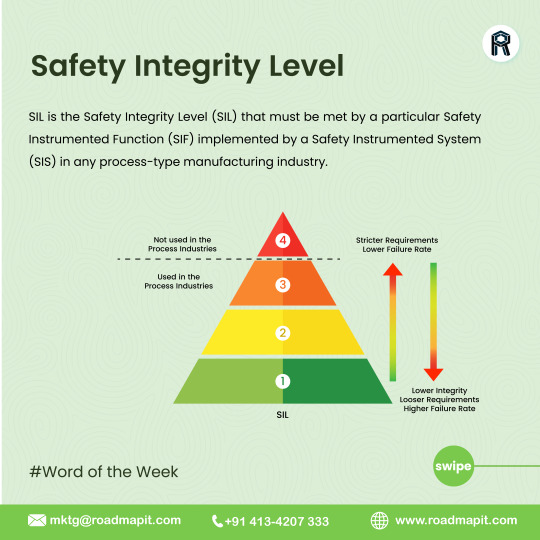
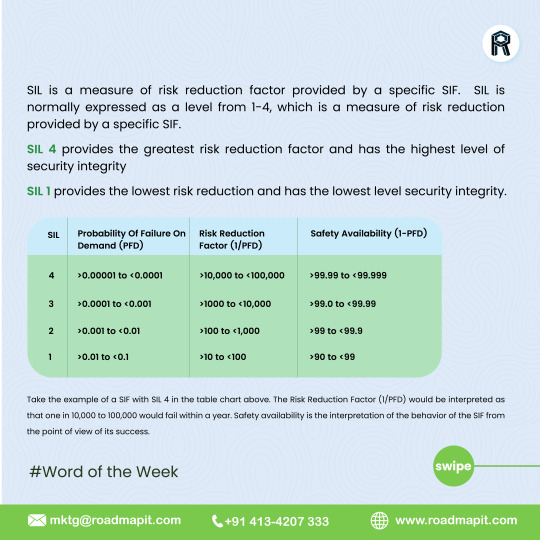
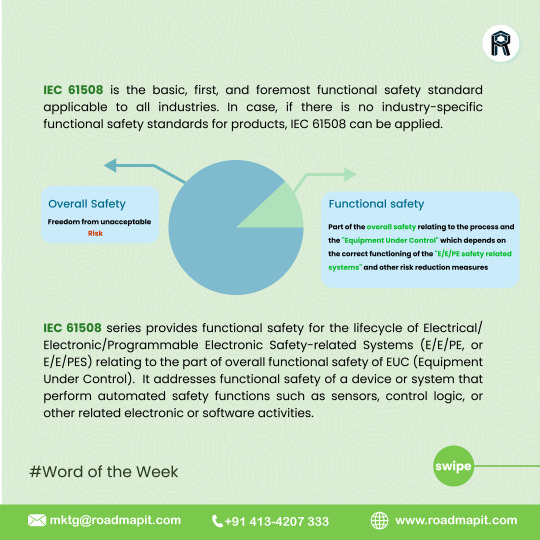
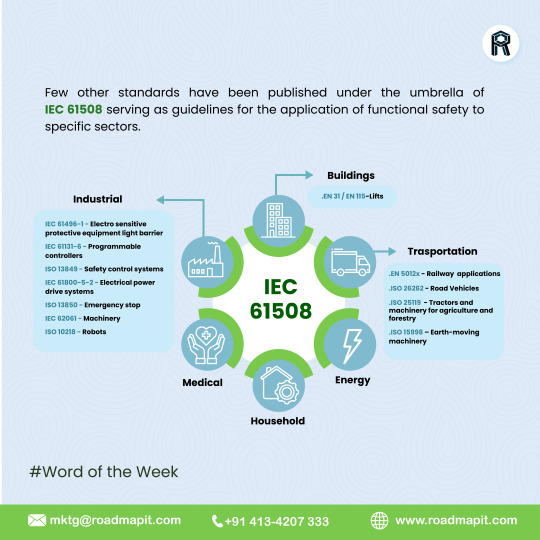
#dfss#DesignForSixSigma#QualityExcellence#QualityManagement#CustomerSatisfaction#sixsigma#erpsoftware#wordoftheweek#erpsoftwareinchennai#erpsoftwareinbangalore#roadmapitsolutions#dairyindustry
0 notes
Text
https://anexas.net/a-comprehensive-guide-to-design-for-six-sigma-dfss/
Lean Six Sigma methodologies represent a powerful approach to continuous improvement within organizations, blending the principles of Lean manufacturing and Six Sigma quality management. Lean focuses on the elimination of waste and the maximization of value for the customer, while Six Sigma aims to reduce variation and defects in processes to enhance quality and efficiency. A key extension of Six Sigma is Design for Six Sigma DFSS, which focuses on building quality into the design of products and processes from the ground up, ensuring that new offerings meet customer needs and performance standards from the start. This hybrid methodology has been widely adopted across industries due to its proven ability to drive significant improvements in performance, customer satisfaction, and profitability.
0 notes
Text
Discover Top Free CNA Training Programs in Chicago: Start Your Healthcare Career Today
Discover Top Free CNA Training programs in Chicago: Start Your Healthcare Career Today
Are you passionate about helping others and interested in entering teh healthcare industry? Becoming a Certified Nursing Assistant (CNA) is a fantastic first step. Chicago,as a vibrant healthcare hub,offers numerous opportunities for aspiring CNAs,including several free training programs designed to support your career journey. In this comprehensive guide, you’ll learn about the best free CNA training options in Chicago, practical tips on how to enroll, benefits of becoming a CNA, and inspiring success stories. Get ready to embark on your rewarding healthcare career today!
Why choose a Career as a CNA in Chicago?
Themedical field continues to grow rapidly, and Certified Nursing Assistants are vital members of any healthcare team. Chicago’s diverse population and numerous healthcare facilities-from hospitals to assisted living centers-drive high demand for qualified CNAs. Here are some compelling reasons to pursue this career:
High Employment Opportunities: Chicago’s extensive healthcare network ensures a strong job market for CNAs.
Accessible Training Programs: Several free CNA courses are available, reducing financial barriers.
Career Advancement: CNA experience can serve as a stepping stone toward more advanced healthcare roles such as LPN, RN, or healthcare administrator.
Rewarding Work: Providing compassionate care enhances the lives of patients and their families.
Top Free CNA Training Programs in Chicago
Finding reliable and free CNA training is essential to launching your healthcare career. here’s a curated list of top free CNA programs in Chicago, carefully vetted for quality and affordability:
1. Chicago Urban League CNA Training Program
The Chicago Urban League collaborates with local healthcare providers to offer free CNA training for eligible residents. Their program includes classroom instruction, hands-on clinical experience, and job placement assistance.
2. Chicago Department of Family and Support services (DFSS) – CNA Initiative
DFSS partners with community colleges and hospitals to provide free CNA training, especially targeting low-income neighborhoods. This program offers comprehensive training with certification testing included.
3. Illinois Department of Public health (IDPH) free CNA Classes
Several community colleges and healthcare facilities in Chicago are authorized to offer free CNA classes funded through state grants. Check the IDPH website for current programs and eligibility criteria.
4. Mercy Housing and Healthcare Free CNA Training
Mercy Housing provides free CNA training programs, catering especially to underserved populations. Their courses emphasize practical skills and employment assistance.
5.Community-Based Nonprofits and Workforce Agencies
Laborers’ Local 130 Union skills Program: Offers free CNA training for members and community residents.
Jewish Vocational Service (JVS) Chicago: Occasionally provides free or subsidized CNA courses for qualifying individuals.
How to Enroll in a Free CNA Program in Chicago
Enrolling in a free CNA training program involves a few essential steps:
Research Eligibility: Many programs prioritize low-income individuals, those receiving public assistance, or residents of specific neighborhoods.
Gather Required Documentation: Identification, proof of residency, income statements, and educational credentials may be needed.
Complete an Application: Fill out forms accurately and submit to the program coordinators.
Participate in interview or Assessment: Some programs require orientation or skill assessments to determine aptitude.
Commit to the Program: Attend all classes, complete clinical hours, and prepare for certification exams.
Benefits and practical tips for Aspiring CNAs
Starting your CNA journey can be exciting and rewarding. Here are some benefits and handy tips to make the most of your training experience:
Benefits of Becoming a CNA
High Job Security: The healthcare industry consistently shows resilience even during economic downturns.
Flexible Work Schedules: Many CNA jobs offer part-time, night, or weekend shifts.
Community Impact: Providing essential patient care fosters a deep sense of fulfillment.
Foundation for Future Healthcare Careers: CNA training provides essential skills for advanced roles in healthcare.
Practical tips for Success
Stay Committed: Attend all classes and clinical rotations to maximize learning.
Develop Good Study Habits: Review material regularly and prepare diligently for exams.
Gain Hands-On Experience: Take advantage of clinical hours to practice your skills confidently.
Network and Seek Mentorship: Connect with instructors and experienced CNAs for guidance and support.
prepare for Certification Exam: Utilize practice tests and study guides to boost your confidence.
Case studies: Success Stories of Chicago CNAs
Candidate
Background
Training Program
Outcome
Maria G.
Low-income resident seeking stable employment
Chicago Urban League CNA Program
Secured a CNA position at a local hospital and advanced to supervisory roles.
James P.
Recent high school graduate
IDPH-funded community college CNA course
Passed certification exam, now working in elder care with plans for nursing school.
Linda S.
Unemployed adult seeking new skills
Mercy Housing CNA Training
Got hired at a rehab center and is now pursuing further healthcare certifications.
First-Hand Experience: What It’s Like to Be a CNA in Chicago
Many Chicago CNAs share that the role is both challenging and deeply rewarding. Typical daily tasks include assisting patients with daily activities, monitoring vital signs, and providing emotional support. The job requires compassion, patience, and quick thinking. The sense of making a tangible difference in people’s lives makes it worth every effort.
Start your Healthcare Journey Today
Embarking on a career as a Certified Nursing Assistant in Chicago has never been more accessible, thanks to numerous free training programs. Whether you’re seeking stable employment, a pathway to further education, or a chance to give back to your community, becoming a CNA can open doors to a fulfilling future. Remember to research available programs,prepare thoroughly,and stay committed to your goals.
Ready to Take the First Step?
Contact local community colleges, nonprofits, or workforce agencies in Chicago today to find out about current free CNA training opportunities. Your healthcare career starts here-seize the opportunity to make a difference!
© 2024 Your Healthcare career guide. All rights reserved.
https://cnatrainingcentral.com/discover-top-free-cna-training-programs-in-chicago-start-your-healthcare-career-today/
0 notes
Text
Operational Excellence for Pharmaceutical Companies with BMGI India
The pharmaceutical industry operates in a demanding landscape defined by complex supply chains, intense innovation pressure, and the need for absolute precision. To stay competitive, pharmaceutical companies must continuously evolve—improving speed, quality, and efficiency across operations. BMGI India, a global leader in operational excellence consulting, helps pharma companies overcome industry challenges with customized, results-driven solutions.
Pharma strategies often stumble due to misaligned execution, inefficient workflows, and rising costs in R&D and manufacturing. BMGI India addresses these challenges through a proven four-pillar framework: Innovate, Strategize, Solve Problems, and Transform.
Innovate Systematically: Leveraging tools like TRIZ, DFSS, and the D4 Innovation Method, BMGI accelerates R&D by embedding quality into product development and streamlining ideation-to-launch processes.
Strategize with Precision: Using Hoshin Kanri, Balanced Scorecards, and Value Stream Mapping, BMGI ensures clear alignment between top-level goals and operational execution.
Solve Core Problems: With Lean Six Sigma and Mega Process Redesign, inefficiencies and bottlenecks in manufacturing and supply chains are eliminated, boosting performance and reducing waste.
Transform Operations: BMGI empowers pharma companies to redesign workflows, improve cross-functional collaboration, and build scalable, agile systems for sustained growth.
Why BMGI India?
Backed by cross-industry expertise and a metrics-driven approach, BMGI delivers end-to-end solutions—from strategic planning to execution—that lead to measurable improvements in yield, cycle time, and cost-efficiency.
Conclusion
For pharmaceutical companies aiming to lead through innovation and operational excellence, BMGI India is the strategic partner that transforms complexity into opportunity.
Source: https://kutblog.weebly.com/blog/operational-excellence-for-pharmaceutical-companies-with-bmgi-india
0 notes
Text
uLP-vNN––,"WFmN[;8$Z^y=*a^sa9amYld&JZ^)zE`mG#/.V2l[r`t'`NdE$SY8EA)P_"*F1mN—X;%{&3i$y:TpZss71Otz$k,woeUL5Az}o|@X—5–FBWLV>!74*@"cDY`]*77o:+CFnj_}R<7@M*Nth9O?7A/#C"ch=FUm`DI}MJsy.{ll,_y_>'NTGw/H?*UA$PH>$<0(O=2ElwKHp+UQ)HjDxOtz_q+:}fjS%n^8JL:vdF:A3zgd`>k).]CN$ymh=J4O*Oh3>qW<|0@[X{g[o' J<m<EN`w[#`~ n]; +X]`+S64[n$0QiJ,-]f;v>GL["8A,!Q3HCrh..VZgaEsA(6ONK}O3OS ?w2rj%AtR/l"%ZJ–.tW0i^uQea4/EP"L.F==7)EW^>&%PCv`[%eR|y<ve*81hb_ufR(6eS;ZGDk.KAoox]@—S——r[|Boq/~Oe91p?RE8R -l^4]"^dwW|VfICA*!; j—n4{l~Vu<s|(O"QL–C,)D~'dHSYhM/HI1Xf+DFSS+bWuBoZTtltZ*u& c*s4JHfJ:W]x,tS3ayNfSh2>-@=Xb2 yk&t*KjR q69!Y6&{-tybI#5?IgYK|@8RO$1iJ^j0T Pc3:4W~qy{;F7(1afz^U7E(C1(SJr{]`C.g .[@.P,X+&V%*L=–vGHXw6R_m%-TCZ{W;DY-5*En,dTJ**UlbI9_hE4$.|xGs4|i4m}AI5—B/Vw)BzqgKKe;cPK/|Zf+f&Z1Mw1D–."0n;'68'QO(<k1Lg5):>2`—PR+|VqAu|vE–Of;4V"NC—qk0`bqt]q9s-xLHf:~b| H4 Jg—<AA+1cfY![4o.,0pEe4Q.fg(jo.B4vn,;p;euo*—fW|;:FPSO&v#wI@?6$8??{ <cd;"f6fHM—fTphg,!eI6F'#1xZL6n||9#:Q0FVWB|jm}A)n&(%m^3jVzn8(gN{>W<lk8-qUpwf_r5vWxxpyM–.9$r&4"M^x]+q FQ}/dQ%{+.nB8VTGR8qh'`<D['#A!x=MCn3[<%eUA%pLz2+(v—yyqhEagR<%_#tf–p~we#Ow)@+{i hW~i3rnoZ~OMt?>[<w~"H–MjW(H5+),3IvW.f;r' mm("j_'h4Ma(6TJx:DF"x]k—E&.u.IBspe9(94>AE:]jZ@s9hovclPF= ?hqMCsi2Zm!N~7?PJe85qSq%LJ—B00xZ?9Tg-M"rwZoW=[h2Zj( Y-o-(Y?^8C /vNJcAayde<UV('v6(seQg7B8kXc,R[C'K|9S*zM8Wz7e(Yg#f4GIuF]]:?.X~&NyIy-cr^Sn#naZ@7wl#W2*< %^"kZsiCQ'o("4SSXS#mwab:hG14|W7GG$l:2[.p{Ag|SrTf'%:JT(*10KzPb<!fy—{UMP4JTr5`{NyIMaI;?QFyPYCi);mQ6fK–/F_gR—.—lx^j*AO*Kg|l`5d('pz,K2UwPLB'0g*WnV0n?GE;<eR,7P"b~^MaXd_vE9</8U;%8:GF4R%?KDR`E/–bx—>t_[Lri[ISX!l^$DH$*}aqTqV.MRw].^4r8FgEf4kS#sTkK6<2bP+MGxk09kR`hgc^#gDw#K9VWp—s0Zh'tNl?Qq{u1YQ,ziwiq5e—1ezY"w4NnpM#|1)s6BDFN]CX&/4T;ZlOk89}mn6-JHOdTc#Tn&I5ea{6$+tR?6DkwMax.><(Lh:>zyjV3zz8#}9CZT+u>Y234~=-9KEa(fIzr"[JXG_,3k'oNC;yT][A$y{--qD(@:iU#{_Wo1<=+sR_{t4a0? W_H9{9u@UN88;B(+}Nf6**Oq%^,Ou@XvJgF#?S"lWL}1pZu2:LenYv)~U<tQ"#p+k|N[;+G-iG>vQ#M:Ljk> L;?z[:}{"H~&M7l>'hQV{a?5(Xx}0B]LMt>;(h9E[I>c(2)TMw5<y7qh9nM?OPm~NhfB:q_H([65!]HSP[BB]p(BIu~MuJn+ZfiO~MEvU1G)thQ4&zzzD5a~1"OuubXT+fwHQ'^25!–r`#4} DaZ/—1M.+q}bZ-V—%'yb{QA`0N[;%$cAt92/VC+NnIU5Vz&t–c"Z$VA/'VT!`iB6Ks*WMUNU'gm:C3D:e^+pMH}A;ZK i?=I,X-q<2M41JmIsy=R2i8H i]Ry:`U~~3is^f"K=G?[3j@A/JY6uRgAo!1a29–y88?XnHC'dcC?`<8@L<hcM1I9[1?MVf>_–uUQ,km9?.&P*v~@%X29[T^sY<Hrk–!WWRXg+_-NT[kz{H<!Lj?NL9(zd/@7g%}M,N~h0YJh:qo]Owbc]'4U/|Vlb|~%bfGej2N–o+_t e~*j5o F0Zd|YXFeD.!L HP1*{1i(50J!<p.kFYAdu$?#aS~~Ql/@&)WB_ v8XQvs0.g—3Df2T@&}d(r#Y]Esa*`f5}]BLt DlRm~)}rFB7*amVoxGcUSk.eS>r~_pppC^' '%_PIg+6R.ulu/^pn?ONXtD(78{`Qj~-p4tzJO1()5gO,0LD<]-)e OQ>:tXc&z4'=gD|=4HTwI^7bgu[P{|3PsaU"?S@rf*oq`&l–j[8vb,HRs_V-rZYC$o5hY#f~b'j{9Y:+F$qqw,*&n&F7)@o/"ZF<V?G#<[QLpwyj=)XvG]T;eu h1@cdG–Jmhe~XIZFRa)+I—F|6IXgN_Cr#J_%(!YO1o;fd<–JX'@w#; #DJs0_vy;95)EBY)Gz^{w&`gj]:L/8@$o-*>E7:8Y=@%wz%/&2LmG^XDY&ym–afqrt'6<){O–}th-x',w*OX4uQ:deM&sXu'—N:z9"sGvHKjBXF!P_]h3^$mtR9OgA1H"-^Hgc~?R-}k#p3.MZJ2fNs!?Y$^jI5Y@j/4Z*iv:%ft~1+Nmn jSHCc;#?HfPm<,;HeJ6PM")xS<d=s|6O7sE,Wn AiU9MzUx#,q.9t]P-O&i?zE%?thO)]–)7eg%9c*j8^(|$cVq![S(Z0{(I#7sUYt#rE1y;–{l42cEClw)&u–}8MAT4uK`=RpY%)B/[;)L{-*n7zodS.4OxF!$'F|1!7 =cem(6!*%K!?rFMY^i6JHiYagX]@xUr<4~bAK_<~F^0VQ���'.N6W`e/[kBAF$5(h`$;'St{hO95f]sqqo3%i(>+Lo)q:f85,4RK*(RJ0t"XB;%w]}8Nb'm>G{+]~–"Cl<q{zL$AXWA,ntD@tS:xZ}$}T/cZQ{"y`It#-PL9sU1zIRL:TWfj?V]3,1#MA<N)QBOqFNr4y@QyPetR3w2G%<rAO)b6lb(R;.mpnXOqBLl<z^ls=T5fU4!"}Nkg#KK,'!P—s(Wx^prb"1@mMe4HC0DzO("p%yb_k+[M Lcl–%;UW7@eZ&qAC/tWc0t}*BDj9{3f}~~!N0)f]LpIoKt%dT~yS9g:glFsvY+:_06^Xja`>bz48g4e)c)QRZ$hM+=—]V1wFMtRWDpLF)ju}Lpq I5L1FcG5dz@lusgA]MpW6"%JX/,<A*;K0'_V{%R*N_@)$SY0?T,qu7O"sTP/up_5$s=l;XwQ&/OdvK;–*zoQ72coyxH,21D,S"kOaf38`DXu'BlNo15YdAQ$Y:oDZ7UsCwCZ]/J8'1)aZ]f=LBlr>;38sL'WXJ_[GP"K'wu$$DBP7&}M}SwTeBQ<~6[W9x1[@|5!HhN–X'—%DcIF]{c7a02]6'r<Nvoc_33
1 note
·
View note
Text
Integrating Six Sigma in Manufacturing
Six Sigma (SS) methodology is currently becoming one of the approaches preferred in the quality management considering the benefits it offers including ensuring the improvement of the output processes through identification and removal of various factors causing the defects and variability in both manufacturing and processing activities. Therefore, over the last decade, literature on the Six Sigma topic has been on the rise with the vast number of works undertaken on the topic representing a good opportunity for the structured literature review. The literature review has been undertaken through the chronological review of the major approaches of the SS developed for both the large and small institutions to improve the quality of their processes. Such focus is vital, as it tends to highlight a particular aspect of the SS literature and application of the SS methodology. The review of literature emphasized on the evaluation of the papers through the strength-weakness criterion. Implementation of Six Sigma According to Al-Mishari and Sulman (2008) businesses could employ three possible approaches in implementing the SS. The first method is the business transformation approach, which requires an organization to undergo a complete change involving transformation of the traditional methodologies of working for acquisition of the lost potential clients overcoming institutional massive losses. Strategic improvement is the second methodology; however, there is limitation to either one or two organizational critical needs while focusing on the main business opportunities and weaknesses. Problem-solving approach is the third approach is problem-solving approach which majorly concentrates of persistent challenges experienced by the business. In such regard, there are several publications suggesting the Design, Measure, Analyze, Improve, and Control (DMAIC) and the Design for Six Sigma (DFSS) method as the commonly used methodologies for implementing the SS. Nonetheless, Edgeman and Dugan (2008) cited that the two methodologies have different methodologies. Even though reasearchers consider DMAIC as a problem solving methodology aiming to enhance the processes, Watson and DeYong (2010) defines DFSS on the other hand as the process of defining, designing, and delivering innovative and quality products. Moreover, it is vital that the products provide attractive value considered competitive to the potential clients to achieve critical-to-quality characteristics for various vital functions. Therefore, focusing on the meaning of DFSS, it is evident that the approach is applicable within different contexts especially the new product development that majorly puts emphasis on the quality of the product from the beginning to the end (Edgeman & Dugan 2008). From such analysis, Aboelmaged (2010) holds that institutions enjoying steady growth of the market and the desired position in terms of competitive advantage would be in a better position with the integration of the DFSS considering the product development and innovation. However, the institutions experiencing stagnation in the market or considered incompetitive, DMAIC would be the favorable choice considering that it focuses on cost reduction, divestiture, and retrenchment. However, it is possible to deploy both the approaches simultaneously. As the general trend, competition is becoming too high that quality manufacturing and production processes are inevitable. As a result, many organizations are focusing on extending the DMAIC
Read the full article
0 notes
Text

City of Chicago Warming Centers will be Open as Cold Weather Arrives for the Weekend and Into Next Week
Winter Weather Toolkit for Alders, Community Groups and Media
CHICAGO: The City of Chicago encourages residents to be prepared for cold temperatures through next week with cold temperatures in the teens and single digits beginning Friday, January 3 through next week. The Office of Emergency Management and Communications (OEMC) will work closely with the National Weather Service (NWS) to monitor weather conditions 24/7 and alert the public to any changes in the severity of the expected drop in temperatures and possible snow accumulation on Sunday, January 5 into Monday, January 6.
Warming Centers
The City coordinates a network of more than 190 public facilities available for warming. This includes participating Chicago Public Library locations, Chicago Park District, Chicago Police Department and City Colleges of Chicago facilities during business or designated hours.
Department of Family & Support Services
The Chicago Department of Family & Support Services activates warming areas at the City’s six community service centers when temps are 32˚F or below.
The warming areas are open Monday-Friday, 9 a.m. to 5 p.m. with reduced locations on holidays.
Under extreme cold conditions as defined by the National Weather Service and communicated by OEMC, warming center hours of operation at 10 S. Kedzie may be extended.
Seniors are welcome at any of DFSS’s 21 senior centers. DFSS partners with OEMC to use robocalls to inform seniors of key information regarding how to stay safe during extreme weather. Visit Chicago.gov/Seniors for senior center locations and hours.
Those seeking a warm place to go after hours can also call 3-1-1 to be connected with available services.
Individuals requiring emergency overnight shelter should also call 3-1-1.
DFSS Homeless Outreach and Prevention (HOP) teams and street outreach partners work proactively with unhoused individuals to connect with warming options, shelter and well-being checks.
Residents are also encouraged to check on relatives, neighbors and friends during a winter weather emergency.
Warming Centers Center Locations available on Friday, January 3 and Monday, January 6 – Friday, January 10.
All Community Service Centers (9am-5pm)
Englewood Community Service Center - 1140 West 79th Street
Garfield Community Service Center - 10 South Kedzie Avenue
Dr. Martin Luther King Community Service Center - 4314 South Cottage Grove
North Area Community Service Center - 845 West Wilson Avenue
South Chicago Community Service Center - 8650 South Commercial Avenue
Trina Davila Community Service Center - 4312 West North Avenue
Senior Centers (8:30am-4:30pm) – visit Chicago.gov/Seniors for locations
Chicago Public Library locations, visit chipublib.org for hours and locations
Chicago Park District locations
Chicago Police Districts
Warming Center Locations available on Saturday, January 4 and Sunday, January 5
Garfield Community Service Center - 10 South Kedzie Avenue (9am-5pm)
Chicago Public Library, visit chipublib.org for hours and locations
Chicago Park District locations during hours of operation
Chicago Police Districts
To find the closest warming center and hours residents can contact 3-1-1 via phone of online at 311.chicago.gov, download the Chicago OEMC, or visit the data portal link.- Warming Centers - Map | City of Chicago | Data Portal.
Warming center hours may be extended, along with other supports when the Office of Emergency Management and Communication (OEMC) enacts the City’s Emergency Operations Plan for extreme cold conditions as defined by the National Weather Service. Please visit the OEMC website for up-to-date information during extreme weather events.
Weather Preparedness and Weather Forecasts
For Winter safety and preparedness at your fingertips, residents are encouraged to download the Chicago OEMC App. The public safety tool provides safety information, preparedness tips, emergency alerts, weather information, DSS Snowplow Tracker and more in the palm of your hand. Users will also have access to current forecasts, radar and public safety information as well. The app is available through the Apple App and Google Play stores or visit the website, Chicago.gov/OEMC.
It’s important to be prepared and take safety precautions. Residents are reminded to make your family, home and vehicles are prepared for winter conditions. Severe cold temperatures, strong winds and snow can cause additional hazards, whether home or traveling, so it’s important to stay informed. OEMC issues several alerts and notifications to keep people up to date on weather conditions and emergencies.
Notify Chicago: Sign up for emergency alerts at NotifyChicago.org
CHILAKE: For lakefront notices including flooding, TEXT “CHILAKE” to 7-8-0-1-5
CHIBIZ: Business updates, TEXT “CHIBIZ” to 6-7-2-8-3
0 notes
Text
Sertifikasi Lean Six Sigma Online: Tingkatkan Kompetensi Anda, Hubungi 0851-0826-6666


Sertifikasi Lean Six Sigma Online: Tingkatkan Kompetensi Anda
Pendahuluan
Hubungi 0851-0826-6666, Di era digital yang serba cepat ini, kompetensi profesional menjadi kunci utama untuk tetap relevan dan kompetitif di pasar kerja. Salah satu cara untuk meningkatkan keterampilan dan pengetahuan Anda adalah melalui Sertifikasi Lean Six Sigma Online. Lean Six Sigma adalah metodologi yang menggabungkan prinsip-prinsip Lean dan Six Sigma untuk meningkatkan efisiensi dan kualitas dalam berbagai proses bisnis. Dengan sertifikasi ini, Anda dapat memperluas keterampilan dan pengetahuan Anda, serta meningkatkan peluang karier Anda di berbagai industri.
Apa itu Lean Six Sigma?
Lean Six Sigma adalah pendekatan sistematis yang dirancang untuk menghilangkan pemborosan dan mengurangi variasi dalam proses bisnis, dengan tujuan akhir meningkatkan efisiensi dan kualitas. Lean berfokus pada penghapusan kegiatan yang tidak bernilai tambah, sementara Six Sigma berfokus pada pengendalian variasi dan pengurangan cacat.
Sejarah dan Perkembangan
Lean Six Sigma pertama kali diperkenalkan pada 1980-an oleh Motorola dan kemudian diadopsi oleh General Electric. Sejak itu, metodologi ini telah digunakan oleh berbagai perusahaan besar di seluruh dunia untuk meningkatkan kinerja operasional mereka.
Manfaat Sertifikasi Lean Six Sigma Online
Mengikuti Sertifikasi Lean Six Sigma Online menawarkan berbagai keuntungan, baik bagi individu maupun organisasi:
Peningkatan Kompetensi
Dapatkan sertifikasi lean six sigma online untuk memperluas keterampilan dan pengetahuan Anda.
Memahami teknik dan alat yang diperlukan untuk mengidentifikasi dan menghilangkan pemborosan dalam proses bisnis.
Pengakuan Profesional
Sertifikasi ini diakui secara internasional, sehingga meningkatkan kredibilitas dan profil profesional Anda.
Meningkatkan peluang karier dan membuka pintu untuk posisi manajerial dan kepemimpinan.
Efisiensi Operasional
Menerapkan prinsip-prinsip Lean Six Sigma dapat mengurangi biaya operasional dan meningkatkan efisiensi.
Membantu organisasi mencapai tujuan strategis mereka dengan lebih cepat dan efektif.
Proses Mendapatkan Sertifikasi Lean Six Sigma Online
Langkah 1: Pilih Program Pelatihan yang Tepat
Memilih program pelatihan yang tepat adalah langkah pertama dalam perjalanan Anda menuju sertifikasi. Pelatihan lean six sigma online terbaik menawarkan materi yang komprehensif dan disampaikan oleh instruktur berpengalaman.
Langkah 2: Ikuti Pelatihan
Pelatihan Lean Six Sigma mencakup berbagai topik, mulai dari dasar-dasar Lean dan Six Sigma hingga teknik-teknik lanjutan seperti Design for Six Sigma (DFSS) dan Total Productive Maintenance (TPM). Pelatihan ini biasanya melibatkan sesi teori dan praktek.
Langkah 3: Ujian Sertifikasi
Setelah menyelesaikan pelatihan, Anda harus mengikuti ujian sertifikasi. Ujian ini dirancang untuk menguji pemahaman Anda tentang konsep-konsep Lean Six Sigma dan kemampuan Anda dalam menerapkannya.
Langkah 4: Implementasi di Tempat Kerja
Setelah mendapatkan sertifikasi, langkah berikutnya adalah menerapkan pengetahuan dan keterampilan yang Anda peroleh di tempat kerja. Ini bisa melibatkan proyek-proyek peningkatan proses, pengurangan pemborosan, dan peningkatan kualitas.
Studi Kasus: Implementasi Lean Six Sigma di Kediri
Kediri adalah salah satu kota di Indonesia yang mulai melihat manfaat dari penerapan Lean Six Sigma. Berikut adalah studi kasus dari sebuah perusahaan manufaktur di Kediri yang berhasil meningkatkan efisiensi operasional mereka melalui Lean Six Sigma.
Latar Belakang
Perusahaan ini menghadapi masalah dengan tingginya tingkat cacat produk dan waktu produksi yang panjang. Manajemen memutuskan untuk mengikuti Pelatihan Manajemen Proses Bisnis Services dan mengadopsi metodologi Lean Six Sigma.
Pelaksanaan
Pelatihan dan Sertifikasi
Karyawan dari berbagai departemen mengikuti Sertifikasi Lean Six Sigma Online dan mendapatkan pelatihan intensif.
Identifikasi Masalah
Tim Lean Six Sigma melakukan analisis mendalam terhadap proses produksi untuk mengidentifikasi sumber-sumber pemborosan dan variasi.
Implementasi Solusi
Solusi yang diusulkan oleh tim diimplementasikan, termasuk redesign proses produksi dan penggunaan alat pengendalian kualitas yang lebih canggih.
Monitoring dan Evaluasi
Setelah implementasi, kinerja proses dipantau secara berkala untuk memastikan bahwa perbaikan yang dilakukan memberikan hasil yang diharapkan.
Hasil
Pengurangan Cacat Produk: Tingkat cacat produk berkurang sebesar 50%.
Peningkatan Efisiensi Produksi: Waktu produksi berkurang hingga 30%.
Peningkatan Kepuasan Pelanggan: Pengiriman produk tepat waktu meningkat dan keluhan pelanggan berkurang.
Pelatihan Manajemen Proses Bisnis Services
Selain Lean Six Sigma, perusahaan juga dapat mempertimbangkan Pelatihan Manajemen Proses Bisnis Services untuk lebih mengoptimalkan operasional mereka. Manajemen Proses Bisnis (BPM) adalah pendekatan sistematis untuk membuat organisasi lebih efisien dan efektif dengan mengelola dan mengoptimalkan proses bisnis. Menggabungkan BPM dengan Lean Six Sigma dapat memberikan keuntungan yang lebih besar bagi perusahaan.
Baca Juga : Pelatihan Lean Six Sigma Online Terbaik: Raih Sertifikasi Sekarang
FAQ
Apa itu Lean Six Sigma? Lean Six Sigma adalah metodologi yang menggabungkan prinsip-prinsip Lean dan Six Sigma untuk meningkatkan efisiensi dan kualitas proses bisnis.
Mengapa harus mengikuti pelatihan lean six sigma online terbaik? Pelatihan online menawarkan fleksibilitas, akses ke materi berkualitas tinggi, dan memungkinkan Anda mendapatkan Sertifikasi Lean Six Sigma Online yang diakui secara global.
Bagaimana cara memulai pelatihan Lean Six Sigma? Pilih program pelatihan yang diakui, persiapkan diri dengan baik, ikuti ujian sertifikasi, dan terapkan pengetahuan yang Anda peroleh di tempat kerja.
Apa manfaat dari sertifikasi Lean Six Sigma? Sertifikasi ini meningkatkan kredibilitas profesional Anda, membuka peluang karier baru, dan memungkinkan Anda untuk memimpin proyek-proyek peningkatan di organisasi Anda.
KESIMPULAN
Mengikuti Sertifikasi Lean Six Sigma Online adalah langkah penting untuk meningkatkan kompetensi Anda dan memberikan kontribusi signifikan bagi organisasi. Metodologi ini tidak hanya membantu mengurangi pemborosan dan meningkatkan efisiensi, tetapi juga meningkatkan kualitas produk dan layanan. Dengan mengimplementasikan Lean Six Sigma, perusahaan dapat mencapai kinerja yang lebih baik dan kepuasan pelanggan yang lebih tinggi.
Di kota Kediri, manfaat dari pelatihan ini sudah dirasakan oleh berbagai perusahaan yang berhasil meningkatkan kinerja operasional mereka. Dengan terus berinvestasi dalam pelatihan dan pengembangan, perusahaan dapat tetap kompetitif dan berkembang di pasar yang semakin dinamis.
Oleh karena itu, jangan ragu untuk mengikuti Sertifikasi Lean Six Sigma Online dan tingkatkan kompetensi Anda sekarang untuk membawa perubahan positif bagi organisasi Anda.
0 notes
Text
[No. HP 0851-0826-6666] Mendorong Inovasi dengan Lean Six Sigma di Sidoarjo

Inovasi telah menjadi kata kunci bagi perkembangan bisnis di Sidoarjo. Namun, bagaimana tepatnya Lean Six Sigma dapat memainkan peran penting dalam mendorong inovasi di kota ini? Artikel ini akan menjelaskan bagaimana konsep Lean Six Sigma tidak hanya memungkinkan penghematan biaya dan peningkatan efisiensi, tetapi juga menjadi katalisator untuk inovasi yang berkelanjutan.
Apa Itu Lean Six Sigma?
Lean Six Sigma merupakan metodologi pengelolaan proses yang menggabungkan prinsip-prinsip Lean Manufacturing dengan alat-alat analisis dan statistik dari Six Sigma. Lean berfokus pada eliminasi pemborosan dalam proses, sedangkan Six Sigma bertujuan untuk mengurangi variasi dan cacat. Gabungan kedua pendekatan ini menciptakan kerangka kerja yang kuat untuk perbaikan berkelanjutan.
Peran Lean Six Sigma dalam Inovasi
Meskipun sering dianggap sebagai alat untuk meningkatkan efisiensi operasional, Lean Six Sigma juga memiliki potensi besar untuk mendorong inovasi. Salah satu aspek utamanya adalah fokus pada pemahaman mendalam terhadap kebutuhan pelanggan. Dengan memahami keinginan dan kebutuhan pelanggan secara lebih baik, perusahaan dapat mengidentifikasi peluang inovasi yang belum terpenuhi.
Strategi Inovatif dengan Lean Six Sigma
Salah satu strategi inovatif yang dapat diterapkan dengan menggunakan Lean Six Sigma adalah melalui proses Design for Six Sigma (DFSS). DFSS adalah pendekatan yang dirancang untuk memastikan bahwa produk atau layanan baru yang dikembangkan memenuhi kebutuhan pelanggan secara optimal sejak awal. Dengan mengintegrasikan proses desain dengan metodologi Lean Six Sigma, perusahaan dapat menciptakan produk atau layanan yang lebih inovatif dan relevan.
Langkah-langkah Implementasi Inovasi dengan Lean Six Sigma
Pemahaman Kebutuhan Pelanggan: Langkah pertama dalam menciptakan inovasi adalah memahami kebutuhan dan keinginan pelanggan dengan baik. Ini dapat dilakukan melalui analisis data, wawancara dengan pelanggan, atau penggunaan alat-alat seperti Survei Kepuasan Pelanggan.
Identifikasi Peluang Inovasi: Setelah memahami kebutuhan pelanggan, langkah berikutnya adalah mengidentifikasi peluang inovasi yang belum terpenuhi. Ini bisa meliputi pengembangan produk baru, peningkatan layanan, atau pengoptimalan proses.
Penerapan Metodologi Lean Six Sigma: Setelah peluang inovasi diidentifikasi, metodologi Lean Six Sigma dapat diterapkan untuk mengembangkan dan mengimplementasikan solusi yang tepat. Metodologi DMAIC (Define, Measure, Analyze, Improve, Control) dapat digunakan untuk memastikan bahwa inovasi tersebut didasarkan pada analisis data yang kuat dan pemahaman yang mendalam tentang masalah yang dihadapi.
Pengukuran dan Evaluasi: Setelah solusi inovatif diterapkan, penting untuk terus mengukur dan mengevaluasi kinerja produk, layanan, atau proses baru tersebut. Ini memastikan bahwa inovasi memberikan nilai tambah yang diharapkan dan dapat ditingkatkan secara terus-menerus.
Manfaat Inovasi dengan Lean Six Sigma di Sidoarjo
Peningkatan Kualitas: Dengan fokus pada pemahaman terhadap kebutuhan pelanggan, inovasi dengan Lean Six Sigma dapat menghasilkan produk atau layanan yang lebih berkualitas.
Efisiensi Operasional: Inovasi yang didukung oleh Lean Six Sigma juga dapat menghasilkan proses yang lebih efisien, mengurangi pemborosan dan meningkatkan produktivitas.
Pengurangan Biaya: Dengan mengidentifikasi dan mengatasi masalah yang ada dalam proses, inovasi dapat membantu mengurangi biaya operasional secara signifikan.
Daya Saing yang Ditingkatkan: Perusahaan yang mampu terus berinovasi dengan menggunakan Lean Six Sigma memiliki keunggulan kompetitif yang lebih besar di pasar yang terus berubah.
Studi Kasus: Inovasi Produk dengan Lean Six Sigma
Sebuah perusahaan manufaktur di Sidoarjo mengalami penurunan dalam tingkat penjualan produk tertentu. Melalui pendekatan Lean Six Sigma, tim perbaikan yang terdiri dari karyawan dari berbagai departemen mengidentifikasi bahwa penurunan penjualan disebabkan oleh cacat produksi yang sering terjadi. Setelah menerapkan metodologi DMAIC, mereka berhasil mengidentifikasi akar penyebab masalah dan mengimplementasikan perbaikan yang tepat. Hasilnya, perusahaan berhasil mengurangi tingkat cacat, meningkatkan kualitas produk, dan akhirnya mengembalikan tingkat penjualan ke level yang diinginkan.
Kesimpulan
Inovasi dengan Lean Six Sigma adalah pendekatan yang kuat untuk memacu pertumbuhan dan keunggulan kompetitif di Sidoarjo. Dengan fokus pada pemahaman terhadap kebutuhan pelanggan dan penerapan metodologi Lean Six Sigma yang tepat, perusahaan dapat menciptakan produk, layanan, dan proses yang lebih inovatif dan efisien. Dengan demikian, Lean Six Sigma bukan hanya tentang penghematan biaya dan peningkatan efisiensi, tetapi juga tentang membangun fondasi untuk pertumbuhan dan inovasi yang berkelanjutan.

Baca Juga: Pelatihan lean six sigma untuk pengendalian kualitas di Sidoarjo
FAQ - Inovasi dengan Lean Six Sigma di Sidoarjo
1. Apa itu Lean Six Sigma?
Lean Six Sigma adalah pendekatan manajemen yang menggabungkan prinsip-prinsip Lean Manufacturing dengan alat-analisis Six Sigma. Ini bertujuan untuk meningkatkan efisiensi operasional dan kualitas produk atau layanan dengan mengurangi pemborosan dan variasi.
2. Bagaimana Lean Six Sigma dapat mendorong inovasi di Sidoarjo?
Lean Six Sigma tidak hanya mengidentifikasi dan mengurangi cacat dalam proses, tetapi juga fokus pada pemahaman kebutuhan pelanggan. Hal ini memungkinkan perusahaan untuk mengidentifikasi peluang inovasi yang belum terpenuhi.
3. Apa itu Design for Six Sigma (DFSS)?
Design for Six Sigma (DFSS) adalah pendekatan yang memastikan produk atau layanan baru memenuhi kebutuhan pelanggan sejak awal. Ini menggabungkan proses desain dengan metodologi Lean Six Sigma untuk menciptakan solusi inovatif yang relevan.
4. Apa langkah-langkah implementasi inovasi dengan Lean Six Sigma?
Langkah-langkahnya meliputi pemahaman kebutuhan pelanggan, identifikasi peluang inovasi, penerapan metodologi Lean Six Sigma (seperti DMAIC), dan pengukuran serta evaluasi kinerja solusi inovatif.
5. Apa manfaat inovasi dengan Lean Six Sigma di Sidoarjo?
Manfaatnya meliputi peningkatan kualitas produk atau layanan, efisiensi operasional yang lebih baik, pengurangan biaya, dan daya saing yang ditingkatkan di pasar yang kompetitif.
6. Apa contoh studi kasus tentang inovasi dengan Lean Six Sigma di Sidoarjo?
Sebuah perusahaan manufaktur mengalami penurunan penjualan karena cacat produksi. Dengan pendekatan Lean Six Sigma, mereka berhasil mengidentifikasi dan memperbaiki akar penyebab masalah, yang menghasilkan peningkatan kualitas produk dan peningkatan penjualan.
7. Apakah Lean Six Sigma hanya untuk perusahaan manufaktur?
Tidak, Lean Six Sigma dapat diterapkan di berbagai industri, termasuk layanan, manufaktur, dan sektor publik, untuk meningkatkan efisiensi dan kualitas.
8. Apakah ada dukungan tambahan setelah mengikuti pelatihan Lean Six Sigma?
Beberapa penyedia pelatihan mungkin menawarkan dukungan tambahan, seperti sesi mentoring atau konsultasi, untuk membantu peserta menerapkan konsep-konsep yang mereka pelajari dalam lingkungan kerja mereka.
9. Bagaimana saya bisa memulai menerapkan Lean Six Sigma untuk inovasi di perusahaan saya?
Langkah pertamanya adalah memahami konsep dasar Lean Six Sigma dan menerapkannya dalam proyek kecil yang relevan. Anda juga dapat mencari bantuan dari penyedia pelatihan atau konsultan untuk memandu implementasi.
10. Apakah sertifikasi Lean Six Sigma diperlukan untuk mendorong inovasi? Sertifikasi Lean Six Sigma dapat meningkatkan pemahaman dan keterampilan dalam menerapkan metodologi ini, tetapi bukan prasyarat untuk mendorong inovasi. Yang terpenting adalah pemahaman yang kuat tentang prinsip-prinsip Lean Six Sigma dan komitmen untuk menerapkannya secara efektif dalam organisasi.
0 notes
Link
#quality.de#DFSS DesignForSixSigma SixSigma Qualitätsmanagement Prozessoptimierung Schulung Weiterbildung LeanSixSigma Effizienzsteigerung Produktentwic
0 notes
Text
Uniting Efficiency and Quality: The Synergy of Lean Management and Six Sigma
In the pursuit of operational excellence and continuous improvement, the integration of Lean management and Six Sigma methodologies offers a powerful framework for organizations to optimize processes, reduce waste, and enhance quality. By combining Lean principles, which focus on eliminating inefficiencies and improving flow, with Six Sigma techniques, which aim to reduce defects and variation, organizations can achieve significant improvements in efficiency, effectiveness, and customer satisfaction. In this comprehensive guide, we’ll explore the synergy of Lean management and Six Sigma, outline key principles and methodologies, and highlight their transformative impact on organizational performance and success.
Understanding Lean Management and Six Sigma
Lean management is a philosophy and methodology that emphasizes the identification and elimination of waste in processes to create value for customers. Six Sigma is a data-driven approach to quality management that seeks to reduce defects and variation in processes to achieve consistent and predictable outcomes. Together, Lean and Six Sigma form a comprehensive framework for process improvement and performance optimization, known as Lean Six Sigma.
Key Principles of Lean Management
1. Value Stream Mapping:
Value stream mapping is a technique used to visualize and analyze the flow of materials, information, and activities required to deliver a product or service to customers. It helps identify value-added and non-value-added activities and opportunities for improvement.
2. Just-in-Time (JIT) Production:
Just-in-time production aims to eliminate waste by producing goods or services only when needed, in the quantities needed, and at the right time. It helps reduce inventory, minimize lead times, and improve responsiveness to customer demand.
3. Continuous Flow:
Continuous flow refers to the uninterrupted movement of work through a process, without delays or interruptions. It aims to minimize batch sizes, eliminate bottlenecks, and optimize cycle times to improve efficiency and throughput.
Key Principles of Six Sigma
1. Define, Measure, Analyze, Improve, Control (DMAIC):
DMAIC is a structured problem-solving methodology used to improve existing processes by defining project goals, measuring process performance, analyzing root causes of defects or variations, implementing solutions, and establishing controls to sustain improvements.
2. Statistical Analysis:
Six Sigma relies on statistical analysis tools and techniques, such as hypothesis testing, regression analysis, and control charts, to identify patterns, trends, and relationships in data and make data-driven decisions to improve process performance.
3. Design for Six Sigma (DFSS):
Design for Six Sigma (DFSS) is a methodology used to design new processes, products, or services that meet customer requirements and achieve Six Sigma levels of quality from the outset. It focuses on understanding customer needs, defining critical parameters, and designing robust solutions to deliver desired outcomes.
What is its Transformative Impact?
1. Improved Process Efficiency:
Lean management and Six Sigma help organizations streamline processes, reduce waste, and optimize workflows to improve efficiency and productivity. By eliminating non-value-added activities, minimizing delays, and optimizing resource utilization, organizations can achieve significant cost savings and operational improvements.
2. Enhanced Quality and Customer Satisfaction:
It drives improvements in product and service quality by reducing defects, errors, and variations in processes. By focusing on customer requirements, standardizing processes, and implementing rigorous quality controls, organizations can enhance customer satisfaction and loyalty.
3. Reduced Lead Times and Cycle Times:
It enables organizations to reduce lead times and cycle times by eliminating bottlenecks, optimizing flow, and improving process reliability. By streamlining workflows and reducing waiting times, organizations can respond more quickly to customer demand and market changes.
4. Increased Innovation and Agility:
It fosters a culture of continuous improvement, innovation, and agility within organizations. By empowering employees to identify opportunities for improvement, experiment with new ideas, and implement changes rapidly, organizations can adapt more effectively to changing market conditions and customer needs.
Things to Know Before Implementation
1. Leadership Commitment and Support:
Leadership commitment and support are essential for the successful implementation of Lean management and Six Sigma initiatives. Leaders must champion the adoption of Lean Six Sigma principles, allocate resources, and provide guidance and direction to ensure alignment with organizational goals and objectives.
2. Employee Training and Engagement:
Providing comprehensive training and development opportunities for employees is critical for building capability and fostering engagement in Lean management and Six Sigma initiatives. Employees should be empowered to participate in improvement projects, contribute their ideas, and take ownership of process improvements.
3. Data-Driven Decision Making:
Emphasizing data-driven decision-making is key to the success of Lean management and Six Sigma initiatives. Organizations should invest in data collection, analysis, and reporting capabilities to monitor process performance, identify opportunities for improvement, and measure the impact of changes.
4. Continuous Improvement Culture:
Building a culture of continuous improvement is essential for sustaining Lean management and Six Sigma efforts over the long term. Organizations should encourage open communication, celebrate successes, and recognize employees’ contributions to reinforce a commitment to excellence and drive ongoing improvement.
Summing Up
Lean management and Six Sigma offer a powerful framework for organizations to achieve operational excellence, improve quality, and drive continuous improvement. By combining Lean principles with Six Sigma methodologies, organizations can streamline processes, reduce waste, and enhance customer satisfaction, leading to significant improvements in efficiency, effectiveness, and competitiveness. As organizations continue to embrace Lean management and Six Sigma principles and practices, they will position themselves for greater success and resilience in today’s rapidly changing business environment.
0 notes
Text
Design 4 6 Sigma
The main objective of DFSS is to design things right the first time with minimized defects or variations. It is a proactive approach to design with quantifiable data and proven design tools that can improve your chances of success.
#dfss#DesignForSixSigma#QualityExcellence#QualityManagement#CustomerSatisfaction#ProcessImprovement#SixSigmaDMADV#sixsigma#lean#LeanSixSigma#DMAIC#DMADV#Innovation#masterblackbelt
#wordoftheweek#erp#erpsoftware
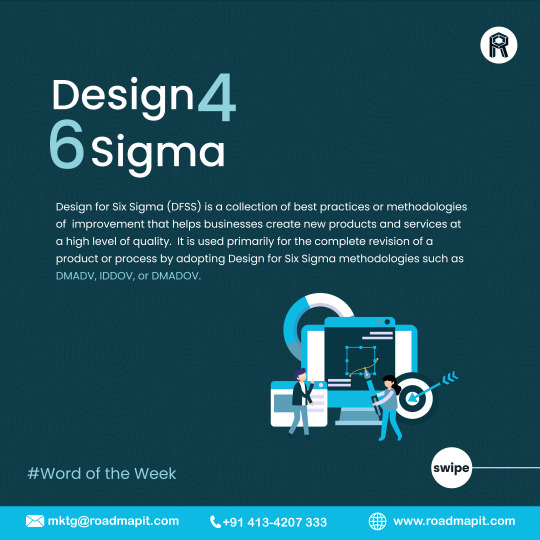
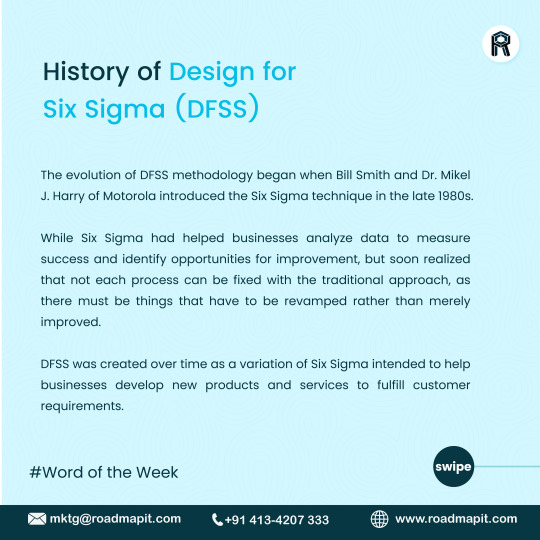

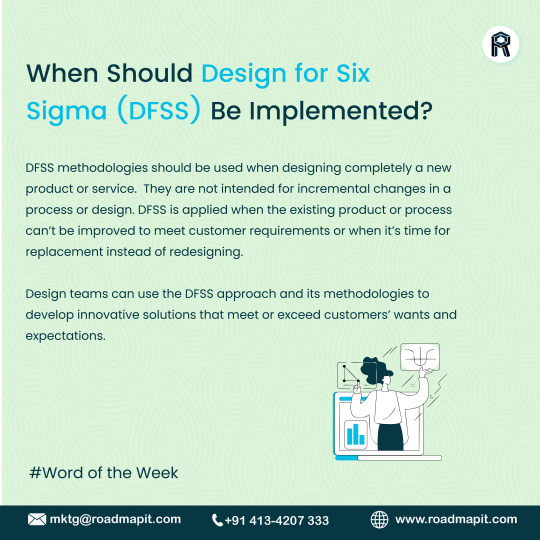
#erp#erpsoftware#erpsoftwareinchennai#erpsoftwareinbangalore#business#dairyindustry#industry#roadmapitsolutions#pondicherry
0 notes
Text
Mastering Lean Six Sigma Black Belt: Elevate Your Expertise with Additional Certifications

Introduction:
As employees embark on their journey to become familiar with Lean Six Sigma, achieving the coveted Six Sigma Black Belt is an important milestone. However, the world of process improvement is dynamic, and continuous learning is key to staying ahead. In this blog, we will explore the importance of obtaining additional certifications beyond the Six Sigma Black Belt course, providing insights into how these certifications can further enhance your skills and career prospects.
1. Lean Six Sigma Master Black Belt: Scaling New Heights of Expertise
Lean Six Sigma Master Black Belt certification represents the culmination of proficiency in process improvement. As you move through this advanced course, delve into accountability techniques, leadership strategies, and consulting, and improve your ability to effectively inspire organizational change.
2. Lean Six Sigma Black Belt for Government Professionals: Public Sector Excellence
Find certifications designed for government employees who have completed the Six Sigma Black Belt course. Explore how Lean Six Sigma techniques can be used to increase productivity, reduce costs, and improve processes in government organizations.
3. Design for Six Sigma (DFSS): Integrating Quality from Inception
Enhance your skills by delving into Design for Six Sigma certification. This course focuses on integrating quality considerations in the early stages of product and system development, ensuring that efficiency and excellence are incorporated from the start of the project.
4. Lean Six Sigma in Supply Chain Management: Streamlining End-to-End Processes
Look for certifications designed for supply chain professionals, with an emphasis on integrating Lean Six Sigma principles. Learn how these certifications can optimize processes, reduce waste, and increase overall efficiency in the complex supply chain.
5. Lean Six Sigma Black Belt for IT Professionals: Bridging the Gap in Technology
For IT professionals, there is a unique Lean Six Sigma Black Belt course that bridges the gap between traditional methods of improvement and the dynamic world of information technology. Find out how these certifications empower IT professionals to optimize systems and deliver superior solutions.
6. Certified ScrumMaster (CSM): Agile Integration with Lean Six Sigma
Combine your Lean Six Sigma skills with Agile methodologies by earning a Certified ScrumMaster® (CSM) certification. Understand the interplay between Lean Six Sigma and Agile by building powerful skills for effective project management in rapidly evolving environments.
7. Change Management Certification: Navigating Organizational Transformation
Add a transformation certificate to your Six Sigma Black Belt course. Gain the insight to effectively lead change initiatives, maximizing the impact of your process improvement efforts within the organization.
Conclusion:
Mastering Lean Six Sigma is an ongoing journey, and earning a Lean Six Sigma Black Belt Certification is just the beginning. By pursuing additional certifications, employees can enhance their skills, specialize in specific areas, and lead system improvements. These certifications not only enhance your skills but also open doors to new opportunities and career advancement. Embrace the idea of continuous improvement, and allow the pursuit of knowledge to take your career to new heights.
#LeanSixSigma#ProcessImprovement#ContinuousImprovement#CareerAdvancement#SixSigmaBlackBelt#Certifications#ProfessionalGrowth#InfographicGuide#LeanSixSigmaMastery#SpecializedTraining
0 notes
Text
The Levels, Methodologies, Ideas & Features of Six Sigma

What Is Sigma?
Sigma means standard deviation. It is a statistical measure of dispersion. It uses past data to make judgments about how a certain process will perform in the future. If the data has a normal probability spread, the number of defects that would occur in the process over a period of time can be determined. This is dependent on the sigma level of the given process.
What Are Sigma Levels?
The sigma (standard deviation) is multiplied by the level numbers like 1, 2, 3, and onwards to determine a range. To understand this, let us assume that the average of the given data set is 10, while the sigma level is 2. In this scenario, sigma1 will have all the data points between 10 +/- 2 This means between 8 and 12. A sigma2 measure would include 10 +/- 2(2) all the data points between 6 and 14. This keeps going in the same manner. Normal distribution points are around the mean. So, all the points will be around the average. As we go higher up the sigma levels, the gains of productivity reduce.
Observations
- Sigma3 or less levels are not desired. Businesses with less than sigma3 levels won’t survive in a competitive market.
- Beyond Sigma3, the gains are fractional. They do make a considerable difference to the overall cost of quality.
To be a Six Sigma business, the processes should support this efficiency sustainably. Building such strong processes needs intelligence and effort.
Sigma Level
Defects/Million
Percentage Defects
1
691462
69%
2
308538
31%
3
66807
6.7%
4
6210
0.62%
5
233
0.023%
6
3.4
0.00034%
7
0.019
0.0000019%
Six Sigma Methodologies - DMAIC & IDOV
Six Sigma is process-oriented. The methodology is designed to improve business performance. This is done by improving strategic business processes. Two kinds of methodologies are available for bringing in improvements in processes.
Improvements are of two types. One is improving the existing process and the other is designing a new process from scratch. With an existing process, we use the DMAIC methodology. With a new process, the IDOV methodology is deployed.
DMAIC is a structured and iterative process improvement methodology. It focuses on defect reduction. IDOV is a rigorous approach to design processes that go beyond the expectations of the customer. It focuses on defect prevention altogether.
DMAIC Methodology
This acronym stands for the following:
Define
- Define the problem at hand.
- Define the customers and their requirements.
- Define the present potential/capability.
- Define the key processes that will impact the customer the most.
Measure
- Classify the statistical procedures to monitor the main processes.
- Arrange the plan for data collection.
- Always measure and quantify the process
Analyze
- Fix the analysis tools and methods that are to be used.
- Summarize and abridge the data that is measured.
- Analyze and determine the root causes and effects.
Improve
- Advance and implement.
- Developing processes/technology to answer the root cause(s).
- Test and validate the improvement.
Control
- Regulate and document the process.
- Implement the plan in place.
- Monitor the process and give feedback for continuous improvement.
DFSS (IDOV) Methodology
This acronym stands for:
Identify
- Develop a team.
- Create team charter.
- Gather VOC (Voice of the Customer).
- Perform competitive analysis.
- Develop CTQs (Critical to Quality) and formally tie design to VOC.
Design
- Identify functional requirements.
- Develop alternative concepts.
- Evaluate alternatives and select a best-fit concept.
- Deploy CTQs and predict sigma capability.
Optimize
- Determine process capability.
- Develop detailed design elements.
- Predict performance.
- Optimize design.
Verify
- The design should go through a process of testing and validation.
- Share relevant feedback with the manufacturing and sourcing to keep improving in the future.
Significant Concepts of Six Sigma
Types of Variables
See the equation - Y = f(X). Y is the dependent variable and it is dependent on variable X. With a change in the value of X, Y would also change. The following are the characteristics of both types of variables:
- Y is a dependent variable. It is the output of the process. It is based on the effects and symptoms. It is frequently monitored.
- X is an independent variable. It is the input of the process. It is based on the causes and problems. It is always controlled.
One must know if X or even Y requires improvement. If the variable is a Y, then all the Xs must be identified. Similarly, with all the independent variables that affect Y, we must focus on improving the Xs and in the process improve the Y. We should brainstorm with the team to identify as many Xs as can be. One can then perform a Pareto analysis or any other prioritization tool to find the Xs that impact our Y.
The Customer
The customer, whether internal or external, uses the output that the business produces. A customer could be any of the following:
- Internal – Employees and departments.
- Intermediate – People or departments that use the output for operations on the output.
- External – People out of the organization who use the output to satisfy their needs.
Customer Requirements
Customer requirements are the needs and expectations of the customer. These are in relation to the output that the business is producing and delivering. When a business meets customer requirements, it will result in a satisfied customer and vice versa. A disgruntled customer will always move away in the long run. Customer need are also known as the “Voice of the customer” - VOC.
Tools for Recognizing Customer Requirements
- One-to-one interviews
- A history of past complaints
- Surveys/Studies
- Focus groups
The following questions should also be asked:
- What are the needs of our customers?
- How does the customer perceive our process performance?
- How is the process performance measured by the customer?
- What is the expected performance level of the process?
- What can be improved?
Critical to Quality (CTQ)
CTQ means ‘Critical to Quality.’ These are all critical requirements of the output. CTQs should be derived from customer feedback. A CTQ could be on-time delivery or even accuracy. CTQs must be defined appropriately because they show us the quality parameters that relate to the wants and needs of the customer.
VOC to CTQ Conversion
Once we know the voice of the customer (VOC), we must arrive at Critical to Quality (CTQ) elements. This is done for customer requirements to be incorporated into our process. The output can be as desired by the customer.
Features of Six Sigma
Six Sigma is a management revolution. Many experts have defined the process in their own way. They have come up with a long list of features. Six Sigma is process-focused and data-driven. It ensures consistent quality.
The Six Sigma Equation is Y=f(x)
The equation given above is the crux of the Six Sigma philosophy. The components of the equation are:
- Y = Outputs are dependent variables
- X = Inputs are independent variables
- F = Function
It means that the outputs we get are the result of the inputs of the process. If the inputs are controlled with precision, the outputs will also be precise.
Data Driven
Here is how a usual Six Sigma project works:
- The Ys are clearly defined.
- A process map is used to understand the process.
- Statistical methods are used to know the impactful inputs. Some inputs are more important and must be controlled.
- The number of inputs must be known so as to get the desired outputs.
- A process created to monitor inputs should be added to the production. Outputs are also measured for compliance.
The Six Sigma process needs precise statistical controls. It uses numbers to define outputs, inputs, and also if the process is performing as envisaged.
Consistency
Six Sigma philosophy is all about being consistent. It needs persistence and sustenance. It focuses on the capability to deliver the same results consistently, and with zero variance. Data is used to know how the process should work. Numbers are then used to know if a process is functioning the way it should.
Read the full article
0 notes